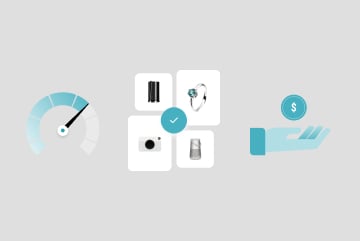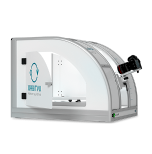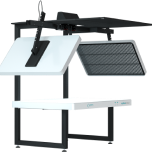Automate to elevate series: increasing ecommerce profitability by optimizing image production
This episode of our Automate to Elevate Series is a preview to our upcoming Live Webinar and focuses on how to increase eCommerce Profitability by Optimizing Image Production.
The ability to deploy online digital assets in an efficient and effective manner can have a dramatic effect on the bottom line for online retailers.
In this video presentation we review a variety of different things, including: the impact of digital content, examples of the types of digital assets being used by online shops today; and we will also discuss the importance of evaluating your current Image Production Process as well as the Challenges and Benefits of optimizing your imaging workflow. Lastly, we will cover how to use technology to help streamline and ultimately optimize your image production process.
Impact of Digital Content
The most important aspect of an eCommerce store are the digital assets that represent the products you are selling. This content is vitally important because it can shape and re-enforce your brand identity. It also has a huge impact on an online shoppers buying experience. Online shoppers can’t touch and feel your products. Digital content places your product in their mind so they can envision how the products looks and feels. The better this buyer experience is the greater the sales conversions. Also, for those that are competing with other online retailers to sell the same products, it offers a huge opportunity to have a competitive edge.
How your products are represented in regard to digital asset type can also have an impact on buyer behavior. If you decide to deploy simple product shots, multi-angle product shots, video content, 360-degree spin presentations or a combination of these – all can have an effect on consumer buying behavior.
Evaluating Your Process
In order to improve on any process, you have to start with a brutally honest evaluation of your current process so that you can build from there. When we work with client’s we ask them to rate their current process of image production, on a 1-5 scale. At Orbitvu USA, we like to use the Gilligan’s Island rating system. For the younger crowd Google Giiligans Island. Number one, you are stranded on an island with no hope. In other word’s – it is Chaos. Number two, you are stranded on an Island but have some crude tools. You are trying to get by with the hope at some point you can build your own boat. We call this Controlled Chaos. Number three, you have a boat, but you spend most of your time plugging leaks. You are surviving, but your time is spent staying afloat, so it is hard to be productive. Number four, you have a boat and some oars. You are moving forward with some ability to be productive on a daily basis, but any large wave or having to row against a current can bring you right back to survival mode. Number five, you have a boat with a big beautiful engine. You can efficiently and productively navigate the waters towards your ultimate destination. So, if you had to evaluate your own current Image Production Process how would you rank yourself? Remember be brutally honest. We find most of our clients score themselves between one and three.
Challenges and Benefits of Optimizing Image Production
Optimizing your Image Production can have many challenges. However, the effort to streamline your process can yield many benefits. The most important include: TIME, COST and the ability to maintain QUALITY and CONSISTENCY.
Time
TIME is the most important because it has a direct impact on all of the other challenges. As discussed earlier in the importance of evaluating your current process. Your evaluation should also include the time it is taking to produce your web content. In this evaluation you need to determine if Time Is Controlling You, or Are You Controlling Time? This really is the basis for deciding to optimize your image production process. If you find yourself on that island, time is most definitely controlling you. You are constantly up against deadlines and you struggle to keep up with demand. Typically, the longer your process is taking the more money it is costing. The main value of optimization is getting control of your time, so you can decide how to best make use of that time. For example, we spoke earlier about different types of digital assets – product shots, 360 Spin presentations, video content etc. Many companies simply do not have time to evaluate which digital assets to deploy to create higher sales conversions, never mind actually having the time to create nothing more than the bare minimum. Time gives you the opportunity to assign more readily available resources to create and deploy the best images that generate the most sales. Time constraints also cause Opportunity Lost scenarios. A real-world example of this, is the impact of selling seasonal products. If you are selling fashion related products online, there is a seasonality or window of opportunity to sell your products before you have to start discounting them. If you have a 12 week season to sell a particular product and the first 8 weeks is considered “Prime Selling Time”, what would be the impact of being a week late getting your product images up? You lost a week of selling your product at a premium price. What if you were two weeks late? The impact could be substantial. The sooner you have an image, the sooner you can start selling the product. There is always pressure to get web content created and sometimes you can’t control all aspects of the process, such as having the product actually available to photograph. However, optimizing and shortening the time it takes to photograph your products helps mitigate that threat of losing Prime Selling Time.
Cost
The second key challenge of Image Production is Cost. Typically, the longer a process takes, the more costs are going to be incurred to complete the process. This ties back to our discussion about time. Improving your image capture methods can add efficiency and cost savings to your process. An example of this is the time and cost of bottlenecks in image production, for example, the time spent in post editing. Much of this involves background removal or clipping path work. Whether that is done in-house or out-sourced it can add significant costs and time to your process. We will talk more about this specific subject a bit later. Another cost consideration is Scalability. With most of our clients we work with we find that as their image production volume increased, their cost of imaging increased at a similar rate. Without optimizing production, you have a difficult time controlling production costs over time. This inefficiency puts a strain on your ability to grow and puts an even larger strain on your image production budget. In our self evaluation scenario, this is where you end up on the boat patching leaks. Optimizing your image production and using the right tools allows to scale your process which will have a positive effect on your costs and once allows you to take control of your time.
Image Quality and Consistency
The third most important challenge of Image Production is Image Quality and Consistency. Earlier we looked at the Impact of Digital Content on your webstore and the importance of choosing the right type of digital asset and having your digital content properly represent your brand. Having a process that insures the quality and consistency of your digital assets will greatly improve the engagement with your online customers therefore drive sales conversions higher. The longer a shopper stays engaged on your website the more likely they are to buy. Poor quality and lack of consistency can have the opposite effect. It can increase bounce rates, poorly represent your brand and reduce the number of repeat visits. Studies have shown that when digital content is of high quality and has overall consistency such as background color, angles of product shots etc. the shopper stays in a “buy mentality”, however if the images are poor and lack consistency the shopper subconsciously is critiquing the site and your products. They are no longer in a “buy mode” and your sales conversions can go dramatically down. Being able to provide consistent high quality content also allows you to remain competitive if you are competing with other online retailers selling the same or similar products. This will also allow you to compete with large retailers that have more resources and bigger budgets.
How to Optimize Image Production
Having covered the different aspects of Optimizing your Image Production, let’s look at HOW you can go about doing this. The first step, as discussed earlier is to make a honest evaluation of your current process. Next, is to make yourself aware of and learn about the latest tools and technologies. We are always hearing from clients that they just weren’t aware of some of the resources that are available today. Going back to our Island analogy, many think that living on the Island, having time control them is the norm. They do not even realize there are ways to get off the island! Whether you relate to Gilligan the Skipper, the Professor or even Thurston Howell III – Master of your Domani – face it you’re still stuck on the island! So, a great way to start is by getting control of the actual image capture process. It will provide the best opportunity to accomplishing the overall goal of achieving optimization, saving time, costs and flexibility to deploy the most relevant digital assets to best impact your bottom line. So how are we going to get control of the image capture process? We do this by leveraging technology to automate the process.
Automated Product Photography
Implementing an Automated Photography System will reduce image production costs, provide the ability to generate consistent high quality digital content in less time than traditional methods. It will improve time to market and provides flexibility in deploying resources to create the most relevant and compelling digital assets for your or your client’s webstore. So what do you need to look for when choosing a system to help with image production. First, we will look at Identifying Your Challenges and Flexibility Needs. We will then review the question of Control vs Ease-of Use regarding the operational use of a system. Then, we will review how manufacturers of Automated Systems approach systems from both the software and hardware aspect as well as training and support. Lastly, we will talk about a very important topic which is Price vs Value.
Identifying Your Challenges and Flexibility Needs
We discussed earlier about the general challenges of image production. In your evaluation process it is important for you to identify the specific challenges you face. There are many questions to consider. For example, is image quality and consistency an issue for you? Are you constantly up against production deadlines.? Are you unable to control costs or currently have a unscalable process? Where is your bottleneck? In regards to Flexibility – what type of digital assets do you need to deploy? What type of creative resources do you have access to, what are their skill sets and how can they take advantage of an automated system? Look for a system that has the flexibility to create multiple digital asset types in one system. For example, look for a single system that can help you generated still images, video content and even 360 spin presentations. This provides much better long-term value. Once you identify your specific challenges and flexibility needs it will help you invest in an automated system that best matches your needs.
Control vs Ease of Use
When choosing an automated photography system it is important to match the skills of your creative resources with the operational use of the automated system. We just touched on this when discussing the topic of Flexibility. Many companies that are using automated photography systems are using seasoned, skilled photographers to operate the system. It greatly improves productivity. However, experienced photographers require a level of control in their creative process. They want to be able to move and control lights, adjust camera settings like Aperture, Exposure ISO etc. They would like light to use lighting tools such as diffusion to control difficult to shoot products. On the other hand, some companies may not have creative resources with that type of skill set, so having a system that has a simplified interface and templated workflows to assist in productivity and consistency is key. Be sure to identify a system that is flexible enough to accommodate an operator regardless of their skill or experience. Do not sacrifice creative control for ease of use. Identify a system that provides both. Even less experienced operators will develop better skills, so having a flexible interface will provide much better value over time.
Approach of Manufactures of Automated Photography Systems
Manufacturers’ of Automated Photography systems may take different approaches when providing an integrated system. The best providers of any integrated solution are the ones that have the most control of both the software and the hardware. Some providers of automation are software developers of automatic background removal software. They bundle third party hardware like lighting, accessories etc and ship an integrated system. This could potentially cause issues of performance and reliability of the overall system. If the manufacturer of the third-party piece of hardware, goes out of business or discontinues the product that is integrated with your system, you run the risk of early obsolescence of your system. Identify a manufacturer that is the developer of both the hardware and the software. This provides a much better overall integrated system and ensures that functionality and flexibility between software and hardware is optimized yielding the best overall results.
Also, it is important to consider the approach to Support and Training that the manufacturer has. Choose a system where the vendor provides a strong support and training program. Avoid solutions where they rely on out-sourcing these services to 3rd party service companies. Many 3rd party service companies have a contract to supply support and training for several different products and manufacturers. They may lack the quality and attention that you would require. Be sure you are getting support and training from an organization dedicated to your specific solution.
Barriers to Implementation
In this last section, we look at some of the barriers companies face when looking to optimize their image production process. We’ve identified three key Barriers to Implementation: Perception, Ability to Change and Cost.
First we look at Perception. One of the biggest misconceptions of integrating an automated photography system is that they are too expensive. Let’s hold on that subject until we discuss Cost. First, we will look at something we spoke about earlier. The perception that an automated system will reduce the control of the image capture process and limit creativity. This goes back to evaluating a system that provides the best blend of control and ease of use. Automation does not always require giving up control in order to have a productive process. It is important to know about the capabilities and compare the different solutions to see which ones provide that best combination.
The next barrier we encounter with companies is their inability to change. Some companies are resistant to any change in their current process. These are typically the companies that are controlled by time. They simply don’t have the time to evaluate their processes and learn about the latest methods and technologies. They consider their norm to be the industry norm. Their lack of motivation to change is often times related to completely understanding the potential value of change. With so many companies adapting new methods and technologies, the companies that do not change will fall behind and eventually lose to their competitors. They end up stuck on the island.
The last barrier is Cost. And, unpausing our thoughts of our first point, this is also a major part of the perception barrier. When we work with clients they may make the observation that an automated system is too expensive. Our response to this is “Compared to what?”. It is important to be sure of the value an investment will bring before deciding if it is too expensive. This includes many of the things we spoke about regarding an honest evaluation of your current process. Are you on the island? or on a boat plugging holes? Are you experiencing Opportunity Lost situations because you can’t meet production deadlines or can’t provide quality and consistent digital assets for your webstore? Have you considered the value of having scalable costs of image production over time vs your current cost structure. For many, they simply have not had the time to even think about these things. Once again, they are being controlled by time. In order to best evaluate the cost of a solution and whether it is a fit for your situation you must understand the value and impact it can have not only today but over time.
Summary
To conclude, we will look at an example of a client we worked with that wanted to optimize their image production and initially thought an automated solution would be too expensive. Get out your pencil, paper and calculator and do some of your own calculations. This client was shooting about 300 SKU’s a month. For each SKU they shot 4 angles. SO, monthly they were generating about 1,200 images. They were outsourcing the clipping path service and spending on average $1,500 per month. They were a growing online retailer and sales scaling up over the next few years. They were in a seasonal business and on average were missing 5%-8% of prime selling time due to their image production time, including the time to get their images back that they were outsourcing for clipping path work. An automated system provided on-the fly- automatic background removal, immediately eliminating the need to out-source the clipping path service. They also, gained back in most cases all of their prime selling time. They averaged selling 1500 items in a 12 week season. Their prime selling time price average was $149. Gaining back 5% of prime selling time added $3,700 of monthly sales revenue. They deployed their existing creative staff to run the system, significantly increased production, quality and consistency and greatly improved time to market. They also were able to get control of their time so they could now create video assets to their site, which helped improve sales conversion in the first month by 2.5%. This generated an additional $1,800 per month in sales. An additional added benefit was they also had the ability to generate regular content for their Social Media Channels. They did a 3 year lease with a $1 buyout at the end to acquire their photography system. Their monthly lease payment was $875 per month. The cost savings alone of eliminating the cost and time of clipping path service paid for the system. They soon had a good handle on the Value vs Price. The net impact that they could easily calculate was $6,125 per month. That included the total for the added prime selling time sales, the elimination of the clipping path service and bump in sales by improving sales conversions by deploying video content less the cost of the system. This is just one example of how optimizing you image production workflow can have an immediate impact on your sales, on your time and ultimately on your profitability now and even more significantly over time as your business grows and your costs flatten. There are many ways to examine your current production methods and realize the various ways it can help reduce cost, save time and help grow sales. The amount of this impact will scale based on the size of your business. However, regardless of your business size it can have a dramatic impact on your bottom line.
Thank you for for taking the time to watch or read this video presentation. We hope it provided you with some insight regarding the impact that optimizing your eCcommerce Image production can have on your business. If you find yourself stuck on the island, reach out. We have a big boat with a big engine. We would love to learn more about your business and see if we can help.
Products
Products
Articles you may also like

Our lives as we knew it literally changed overnight where almost everything we deemed vital is redundant and obsolete.

You have probably already been listed among Amazon’s 2.5 million sellers (2019) and, as an entrepreneur, you are faced with q...

Located in Atlanta, GA, ORBITVU USA’s 3,000 sq. ft. demonstration and training studio, is equipped with all the latest ORBITV...









